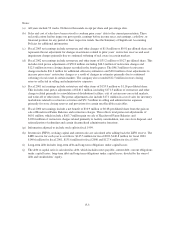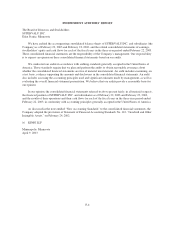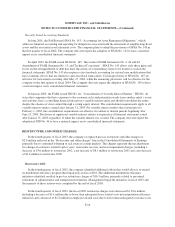Albertsons 2003 Annual Report Download - page 47
Download and view the complete annual report
Please find page 47 of the 2003 Albertsons annual report below. You can navigate through the pages in the report by either clicking on the pages listed below, or by using the keyword search tool below to find specific information within the annual report.SUPERVALU INC. and Subsidiaries
NOTES TO CONSOLIDATED FINANCIAL STATEMENTS—(Continued)
claims incurred but not yet reported, discounted at a risk free interest rate. Any projection of losses concerning
workers’ compensation and general and automobile liability is subject to a considerable degree of variability.
Among the causes of this variability are unpredictable external factors affecting future inflation rates, discount
rates, litigation trends, legal interpretations, benefit level changes and claim settlement patterns.
Property, Plant and Equipment:
Property, plant and equipment are carried at cost. Depreciation, as well as amortization of assets under
capital leases, are based on the estimated useful lives of the assets using the straight-line method. Estimated
useful lives generally are 10 to 40 years for buildings and major improvements, 3 to 10 years for equipment, and
the shorter of the term of the lease or expected life for leasehold improvements. Interest on property under
construction of $5.9 million, $5.7 million and $8.1 million was capitalized in fiscal years 2003, 2002 and 2001,
respectively.
Goodwill and Other Intangible Assets:
In June 2001, the Financial Accounting Standards Board (FASB) approved Statement of Financial
Accounting Standards (SFAS) No. 142, “Goodwill and Other Intangible Assets”. SFAS No. 142 requires
companies to cease amortizing goodwill and test at least annually for impairment. Amortization of goodwill
ceased on February 24, 2002, at which time it was tested for impairment. Each of the company’s reporting units
was tested for impairment by comparing the fair value of the respective reporting unit with its carrying value.
Fair value was determined primarily based on valuation studies performed by the company, which considered the
discounted cash flow method consistent with the company’s valuation guidelines. The company performed the
second annual impairment test as of December 28, 2002 using the same methodology described above. As a
result of impairment tests performed, the company recorded no impairment loss.
Prior to the adoption of SFAS 142, goodwill and other intangible assets were amortized on a straight-line
basis over an estimated useful life, or if no useful life was determinable, over a period no greater than 40 years.
Goodwill is shown net of accumulated amortization of $218.5 million at February 22, 2003 and February 23,
2002.
Retirement Plans:
The company sponsors pension and other retirement plans in various forms covering substantially all
employees who meet eligibility requirements. The determination of the company’s obligation and expense for
pension and other post retirement benefits is dependent, in part, on management’s selection of certain
assumptions used by actuaries in calculating such amounts. These assumptions are described in the Retirement
Plans note in the Notes to Consolidated Financial Statements and include, among other things, the discount rate,
the expected long-term rate of return on plan assets, and the rates of increases in compensation and healthcare
costs. The actuarial assumptions used by the company may differ materially from actual results due to changing
market and economic conditions, higher or lower withdrawal rates, and longer or shorter life spans of
participants.
Financial Instruments:
The company accounts for derivative financial instruments pursuant to SFAS No. 133, “Accounting for
Derivatives and Hedging Activities”, and SFAS No. 138, “Accounting for Certain Derivative Instruments and
Certain Hedging Activity, an Amendment of SFAS No. 133”. SFAS No. 133 and No. 138 require that all
derivative financial instruments are recorded on the balance sheet at their respective fair value.
F-12
























